

|
| Elliott Sound Products | Project 159 |
Before I start to describe this project, and exactly like Project 157 (trailing edge dimmer), I must warn any prospective constructor that all circuitry is directly connected to the mains, and you cannot work on any part of the circuit while it's connected to the mains. Measurements are difficult, and you cannot use an oscilloscope to measure anything. One slip of a meter probe can cause instant destruction of you or the circuit. Dead circuitry can be replaced, but you can't!
| WARNING - The circuits described herein involve mains wiring, and in some jurisdictions it may be illegal to work on or build mains powered equipment unless suitably qualified. Electrical safety is critical, and all wiring must be performed to the standards required in your country. ESP will not be held responsible for any loss or damage howsoever caused by the use or misuse of the material provided in this article. If you are not qualified and/or experienced with electrical mains wiring, then you must not attempt to build the circuit(s) described herein. By continuing and/or building any of the circuits described, you agree that all responsibility for loss, damage (including personal injury or death) is yours alone. Never work on mains equipment while the mains is connected! |
You might think that the warning is over the top, but it's very important that the reader understands the hazards of household mains and is aware of the consequences of poor workmanship or incorrect materials used for mains wiring. Any work on the circuits described must only be performed when the entire circuit is disconnected from the mains.
This is one of several 3-wire leading edge dimmers/ fan speed controllers projects on the Net. However, unlike most, this circuit uses readily available parts throughout, rather than microcontrollers which are common in application notes.
As shown here, the dimmer is intended for use with 230V/ 50Hz mains, and there are some modifications needed for use at 120V/ 60Hz. The changes needed are described later in the article. The differences are based on the timing, power supply and the zero crossing detector, all of which must be changed to get the unit to work properly at 60Hz and 120V.
Note that the dimmer described is a leading-edge type (sometimes called 'forward phase'), and is intended for use with iron cored and electronic transformers or small motors (fans etc.). It can also be used with incandescent lamps, and the power rating is only limited by the TRIAC you use and the available gate current.
Do not use this dimmer with compact fluorescent or LED lamps.
A leading-edge dimmer is intended specifically for use with resistive loads, and inductive loads such as iron cored transformers or motors. You cannot (and must not) use a trailing edge dimmer for these because doing so will cause extremely high voltage spikes, which may damage or destroy the dimmer, the load or both.
If you need a trailing edge dimmer for CFLs or LED lamps, then use the one shown in Project 157, which was the basis for the design shown here, but uses MOSFETs instead of the TRIAC.
Because much of this project is based on P157, quite a bit of the text is very similar because both use a similar design approach. Changes have been made where necessary to describe the operation of the TRIAC version described here. So, if you read both articles you'll see similar descriptions, but there are subtle differences so make sure you read all the info. It's also worth noting that this is a comparatively complex circuit for a leading edge dimmer, and it's possible to make one that's a great deal simpler.
The benefit of this design is that it is very predictable, and its performance can be expected to exceed that of any simpler circuit. However, the traditional simple circuits are usually perfectly alright with resistive loads (incandescent lamps, low powered heaters, etc.), and the usefulness of this project is actually debatable. However, it does have one major advantage over simpler types, in that it will fire at the preset level from power-on, and never has to be advanced to a higher level to start working. This is the downfall of many simple TRIAC dimmers, and the effect is commonly known as 'pop-on'.
Traditional (or 'legacy') dimmers have only two wires, and connect between the AC mains and the load. These work perfectly with resistive loads, but become confused and usually cannot function properly with any electronic load. See Lighting Dimmers Part 1 and Part 2 for the reasons. These articles also show waveforms that will help you to understand the way that dimmers work. Many lamp makers have added circuitry that is intended to 'fix' the problems, but it's a fool's errand because the very nature of the load makes it almost impossible to get a result that works with all dimmers.
Many have tried, and so far all have failed. With any given lamp, one type (or brand) of dimmer works, another does not, even though the basic circuitry may be very similar. Invariably, the lamp gets blamed by the consumer, because the dimmer works just fine with an incandescent lamp. Most people do not understand that CFL and LED lamps are different in all respects, and they cannot be compared in any way when dimmers are included.
The only real fix is a 3-wire dimmer, but these are not commonly available for normal household use. It makes things harder that very few houses have a neutral wire available in the light switch wall-box, so to be able to use a 3-wire dimmer you'll need to run a neutral wire, making installation more challenging.
With a 2-wire dimmer, it makes no difference where it's wired in the circuit. It's a series circuit with the lamp, and the dimmer is not polarity sensitive (it can't be because it works with AC) and it can be simply wired in series with the light switch.
A 3-wire dimmer has an active (phase, hot) connection, a dimmed active and a neutral. Connecting things the wrong way around is likely to create some spectacular fireworks, so it is not as simple to install as a 2-wire type. The advantage with non-linear electronic loads is that the neutral provides an absolute reference so 3-wire dimmers can't get out of sync and misbehave.
Why Use A Leading-Edge Dimmer?
The most common lamp dimmers ever made use a TRIAC (a bidirectional semiconductor switch), and these are 'fired' at a predetermined time each half cycle. These are commonly known a leading-edge dimmers, because the AC waveform is turned on partway through the AC waveform. They are also known as 'forward phase' dimmers (mainly in the US).
If the TRIAC is turned on soon after the zero crossing voltage of the mains, almost the complete AC waveform is passed to the load. As the firing time is delayed, less and less of the AC waveform is passed and the load gets less power. Once a TRIAC is turned on, it remains on until the current drops below the holding current (the minimum current the device can switch) and it then turns off. Because it's bidirectional, positive and negative half-cycles are passed to the load. (There are TRIACs that can be turned off when desired, but they are expensive and I've never seen one in a dimmer or speed controller circuit.)
When the TRIAC turns on, it does so very quickly. How fast? I measured a current risetime of 600V/µs without a series inductor - that's fast! This very short risetime generates high peak currents into electronic loads that will eventually cause serious damage to capacitors and some other parts. For this reason, I never recommend using a TRIAC dimmer with any dimmable electronic lamp - neither CFL nor LED. Some lamp makers claim that their dimmable lamps can be used with a TRIAC, but I've tested several and measured the peak current. Without exception, there is a high (although very brief) peak current, and despite its brevity that indicates that parts will be stressed to the point where they will fail prematurely.
Although the usefulness of a leading edge dimmer is seriously diminished, there are still requirements for heater control, fan speed controllers, and some halogen lighting uses iron cored transformers which can normally be expected to last for at least 20 years, and usually much more. For these applications, you must use a leading edge dimmer.
Almost all household dimmers are only 2-wire types (see above), and naturally this applies almost 100% to commonly available TRIAC dimmers. The only exceptions are dimmers that are used as part of a home automation system (e.g. C-Bus or DALI). As a result, all 2-wire 'wall-plate' dimmers not only stress the electronics in the lamp, but they also lose their reference whenever an electronic load is used. This makes them unsuitable for most electronic loads, even if we ignore the high peak current.
Leading edge dimmers always worked perfectly with incandescent lamps, because the filament resistance provided a stable reference so the TRIAC could switch on and off at the right time. The leading edge dimmer described here will also work perfectly with incandescent lamps, but it will outperform most of them and will show no hysteresis (the tendency of many dimmers to refuse to start if set too low when power is applied). The lack of hysteresis means the lamps will come on at any setting - including very low light settings.
It's important to understand that only leading edge dimmers can be used with inductive loads, such as iron cored transformers or motors (many TRIAC dimmers can be used as fan speed controllers). The circuit shown here is designed for inductive loads only (this includes so-called 'electronic' transformers as used for halogen downlights). They are unique in that they work equally well with leading or trailing edge dimmers.
A TRIAC is a bidirectional thyristor, and can conduct current in both directions. In theory, it can also be triggered with either positive or negative gate current regardless of MT ('main terminal') polarity, but there are some things that have to be understood to ensure reliable operation. Quadrant I is the most sensitive, but that's difficult to achieve without using a TRIAC optocoupler such as an MOC3021 or similar. With most TRIACs, triggering in Quadrant IV needs as much as 3-5 times as much gate current compared to the other three quadrants. Other characteristics are also compromised, and it's worthwhile to read up on TRIAC behaviour if you want to know more.
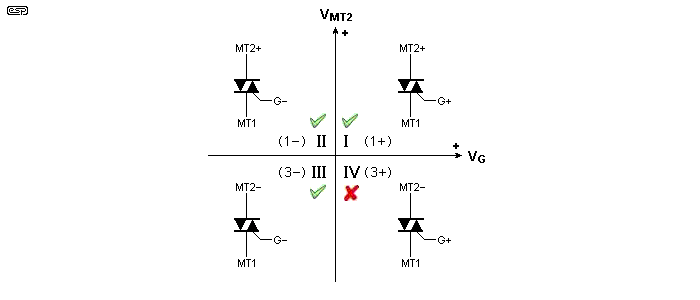
Figure 1 - TRIAC Triggering Quadrants
The circuit described here uses Quadrants II and III (aka 1- and 3-). Gate current is always negative, and the troublesome Quadrant IV (3+) is avoided. If you want to know more about the triggering quadrants and how they affect the TRIAC, please see the references below. For the suggested BT136-600, the required trigger (gate) current is 5-11mA when triggered in Quadrants I to III, but it needs 30mA to trigger in Quadrant IV. Consequently, the power supply is arranged to be negative with respect to MT1, as this avoids Quadrant IV completely.
It's worth noting that some TRIACs are specifically designed to exclude Q4 triggering. These are often referred to as 'snubberless' TRIACs, because by excluding Q4 triggering, the main problems associated with this triggering mode are eliminated. You may also see them referred to as an 'Alternistor' or High-Commutation (Hi-Com) TRIAC, depending on the manufacturer.
Be aware that TRIACs can be temperamental, and with inductive loads you may experience half-wave operation at some dimmer settings. In some cases this can be due to insufficient gate current, and the cure is to provide more. If you are using a capacitor fed supply (as shown in Figure 2), this may not be possible, because the supply can't provide more than about 25mA or so. Half-wave operation can be surprisingly destructive if the load is a motor or transformer, and you must test the circuit thoroughly to ensure that it can never happen in use.
The circuit diagram for the dimmer is shown below. There are four major sections that make up the dimmer. The first is the power supply, which uses a simple capacitor limited half-wave rectifier (D1, D2) and a basic zener regulator (D2). Use of a half-wave rectifier is not something that I'd normally recommend for anything, but in this case it's surprisingly difficult to use a full-wave rectifier because of the circuit topology. The zener diode regulates the voltage to 12V, and while there will be some ripple, it doesn't bother the circuit or upset its performance. See below for an alternative power supply.
The supply is referred to active and neutral, so the return path is straightforward, but the supply itself is ... unconventional. At first look, you may be confused, but what you see is a supply whose output voltage is negative referred to the neutral. This is so the dreaded Quadrant IV can be avoided, and the TRIAC always receives a negative trigger pulse. When a capacitor is used as a current limiter there are no current spikes in the circuit, and although it's a half-wave rectifier, it does not produce any DC component into the mains because of D2.
A preferable power supply is a low power 'off-line' (the input is wired directly to the mains) switchmode supply that has an output of 12V DC at a around 50mA or so. Unfortunately, while these are available, most are fairly expensive (AU$25.00 or more) when 'brand-name' products are used. They are also quite large, with the smallest I've found being almost the same size as a complete Australian dimmer module. These issues may deter you from using a 'proper' power supply, but in the end it's a better option.
The next section is the zero crossing detector, which gives a negative-going pulse when the mains voltage is close to zero. This is used to synchronise the timer to the mains, and is really the heart of the circuit. Without the dedicated zero-crossing detector it can be made to work, but it will never be as good. U2 is an optocoupler, and its LED is powered via R7 and R8, and then from the bridge rectifier. You may wonder how you can use 1N4148 diodes on a circuit that's driven directly from the mains, but the answer is simple. The voltage across any of the diodes can never exceed around 4V or so, because the output (and hence the input) of the bridge is clamped by the optocoupler's LED. This circuit is supplied via resistors because using a capacitor would shift the phase and the zero crossing trigger signal would not coincide with the actual mains zero crossing point.
The timer is based on U1 (a 7555 timer). The timer is a monostable, and is reset at each zero crossing of the mains. When reset, the output (pin 3) goes high (zero gate current), and remains high until the voltage across C1 (charged via R1 and VR1) reaches 8V, when the output goes low. The 555 drives the gate of the TRIAC low, via R3. The TRIAC is therefore turned on when the output of the 7555 is low. The circuit turns off gate drive at the mains zero crossing, and turns it back on after the preset time (~1 to 9.5ms for 50Hz mains).
This circuit needs the 7555 (or TLC555) because the available supply current is limited by the input capacitor. A bigger cap can be used, but it will be so large (physically) that the complete unit will be no smaller than the one shown in Figure 5. A 7555 can sink up to 100mA, so TRIAC gate current will be high enough to ensure reliable operation.
The final section is the power switch, which uses the TRIAC (TR1). When TR1 is conducting, power flows from the active, through the load, then back to the neutral via TR1. The TRIAC's MT1 terminal is connected directly to the neutral conductor. It's also possible to use an MOC3021 or similar - an opto-coupled bidirectional trigger device. While this approach has many merits, it also increases cost and size. I considered this approach, but it was discarded as not being necessary for a low power dimmer. However, if you need to use a large TRIAC to handle the load current, this remains a viable option (see Figure 3). The gate resistor (R3) allows a current of around 25mA, which is sufficient for common low current TRIACs.
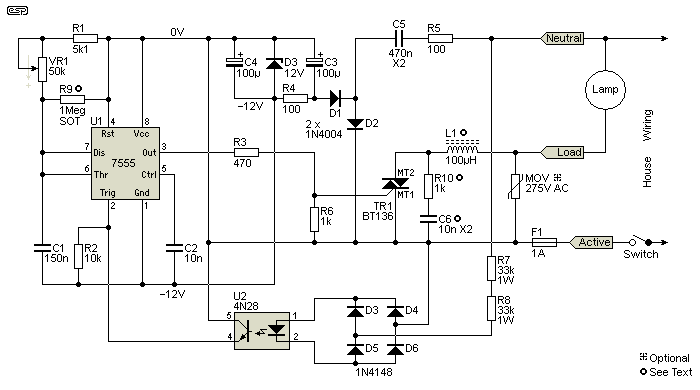
Figure 2 - Complete Dimmer Schematic
If you don't install L1 you will get (possibly severe) interference picked up by nearby radios (especially AM). The inductor will typically be as many turns as you can fit through a small powdered iron (not ferrite!) toroid, using wire that's rated for at least the current you expect your load to draw. There is no practical maximum inductance, so use as much as you can. If you can get as much as 10mH that will limit any interference, but that will be a surprisingly large inductor.
R10 and C6 form a snubber circuit for the TRIAC. C6 must be rated for a minimum of 275V AC, Class X2, or it will fail. Do not use a DC cap here, regardless of its voltage rating. With few exceptions, DC caps are not designed for large AC voltages nor fast voltage risetimes. Note that R10 has to be able to handle very high pulse power (at least 100W for about 1µs), and this calls for a carbon composition or wirewound resistor, or a film type that's specifically rated for high pulse power. Although C6 is subjected to fast pulses, the maximum current is limited by R10.
R9 is marked 'SOT' meaning 'select on test'. The value will typically be around 1 Meg to perhaps 2.2 Meg or so. It needs to be just sufficient to prevent the timer from exceeding 9.5ms when VR1 is set to the maximum resistance (minimum brightness). The need for this has been verified on the simulator and the prototype circuits. Aim for a maximum timer delay of no more than 9.5ms (50Hz) or 8.0ms (60Hz).
The output power level is set via VR1. When at maximum resistance the 555 won't time out until close to the end of the mains half-cycle, so only a small part of the AC is passed before the TRIAC turns off as the mains current passes through zero. At minimum resistance, the timer runs for less than 1ms, so the AC waveform is passed almost in full (see the timing diagrams below). At intermediate settings, the AC is switched on somewhere between the two extremes. Pot rotation is opposite that in the trailing edge dimmer, even though the timing circuits are identical. If used with 60Hz mains, the maximum timeout period has to be a little under 8.66ms, just one of the changes needed for 60Hz/ 120V operation.
The choice of TRIAC is not critical. For most applications the BT136 will be quite sufficient, as it's rated for 4A RMS (with a heatsink). The TRIAC's dissipation is fairly low, but it does have short duration power pulses each time it switches on, and there is also its normal on-state resistance of about 1 ohm. Dissipation with a 1A load will be up to 1W, but with peaks as high as 100W (for less than 5µs). A small heatsink will almost certainly be needed for a current of 1A or more. Feel free to use a BT138 TRIAC if you prefer - 12A RMS with a heatsink.
Obviously, larger TRIACs will handle more power, but they still dissipate up to 1W/amp. Bigger TRIACs need more trigger current (reduce the value of R3), and the power supply will need to be upgraded to suit (see below for an alternative power supply arrangement). A standard 555 timer can sink or source a maximum of 200mA, and if your TRIAC needs more you'll need an output buffer for the 555 and a greatly improved power supply. Power is dissipated when the TRIAC turns on, and the instantaneous dissipation is worst at the 50% setting. Using high power TRIACs (10A or more) will generally require the use of a switchmode power supply to get the required gate current. If you use the BT138 TRIAC, nothing should need to be changed because it has similar sensitivity to the BT136, but is rated for 12A continuous current.
Protection against spikes (in theory) isn't needed with a TRIAC, because a high transient voltage will simply cause the TRIAC to conduct. This is usually (but not always) non-destructive. However, if you wish to include a MOV (metal oxide varistor) then feel free to do so. They come in a bewildering array of different voltage and surge dissipation ratings, and if you are unsure of the best one for this application I suggest that you consult manufacturer datasheets and/or your preferred supplier for assistance. I can't make a suggestion because there are simply too many, and different suppliers will stock types that others don't. Be particularly careful if you plan to drive a transformer or fan motor, as they can generate voltage transients as the TRIAC turns off.
There is one location where resistors are used in series. This is done to keep the voltage across the resistors within reasonable limits. Although you have to search fairly hard to find it, all resistors have a maximum allowable voltage that's independent of the power rating. Using two resistors in series distributes the voltage across each, which increases reliability and reduces the likelihood of the resistors going high resistance (a common failure mode when the voltage is too high). You can use a wirewound resistors in place of R7/8 if you prefer.
As noted earlier, if you need to use a larger TRIAC, you'll need to use a high current power supply and an output buffer for the 555 timer. However, there's an alternative, using an MOC3021 optocoupler. These can provide enough current to trigger nearly any TRIAC you are likely to need, and they operate only in Quadrants I and III, avoiding any triggering problems. The MOC3021 requires an input current of 15mA (maximum, 8mA is 'typical') for full conduction.
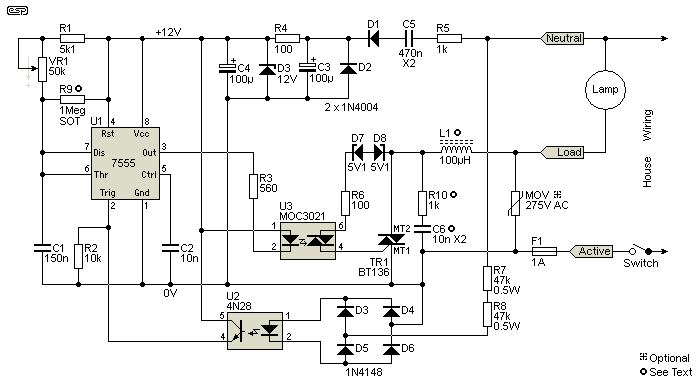
Figure 3 - Complete Dimmer Schematic Using MOC3021
This option can be used with smaller TRIACs as well. The power supply does not need to be negative with respect to the neutral, because only the LED in the optocoupler needs to be driven. I leave it to the constructor to decide whether to use the optocoupler or not. The notes and comments for the circuit shown in Figure 2 apply equally here. The only real change is the optocoupler and power supply, and the remainder of the circuit is functionally identical. Be aware that without the extra zener diodes (D7, D8) the MOC3021 is completely unsuitable for driving an inductive load, because it can easily re-trigger due to the phase lag. The diodes shown will help, but may not be a complete solution.
As a final thought on this, if you happen to have a load that only draws very low current, you can use the MOC3021 directly. The TRIAC isn't used, and the MOC3021 controls the load - R4 and D7, D8 are not used (shorted out) and pin 4 connects directly to neutral. The current is limited to no more than 100mA RMS at 25°C ambient temperature, but that might be all you need for some low-power applications. I doubt if it's very useful, but the option is there is you need it.
As with Project 157, 60Hz operation has not been verified by testing (I don't have a 60Hz mains source available), but there's nothing to suggest that the modifications described here will not work as described.
There are a few changes needed for 120V operation. Firstly, C5 must be increased in value, and the easiest is to use a pair of 470nF caps in parallel. For the zero crossing detector, the total resistance should be around 30k-40k. Two 15k or 18k resistors in series will be fine.
Because the timing is also different, C1 has to be changed. Using 120nF in parallel with 10nF is ideal, giving a capacitance of 130nF and a maximum timeout of just over 7.8ms. It's probable that R9 (select on test) will be needed in most cases to ensure the timeout can't exceed 8.2ms at the absolute maximum.
The most important change is to reverse the active (live) and neutral, now incorporated into the drawings. The US and Canada use ES (Edison Screw) lamp bases, and the outer shell must be connected to the neutral. The load will be connected between the neutral and 'load' terminal, and the switch will be located in the active line as required by wiring codes. For countries where BC (bayonet cap) lamps are standard, it's of no consequence, but many light fittings in Australia are now using ES lamp-holders (for reasons that I don't understand). Where an ES lamp-holder is used, the outer shell must also be the neutral, regardless of any previous connection that may have been used.
With a circuit such as this, you need some waveforms so that you can see exactly what's supposed to happen. If you want to take similar measurements the circuit must be isolated with a 1:1 mains isolation transformer, and be aware that everything is perfectly capable of killing you (or your oscilloscope), and if you normally use a safety switch it won't work if you make contact with live parts. Serious injury or death are very real risks. No, I'm neither joking nor exaggerating!
The waveforms shown were taken from a simulator, but the real thing will be no different.
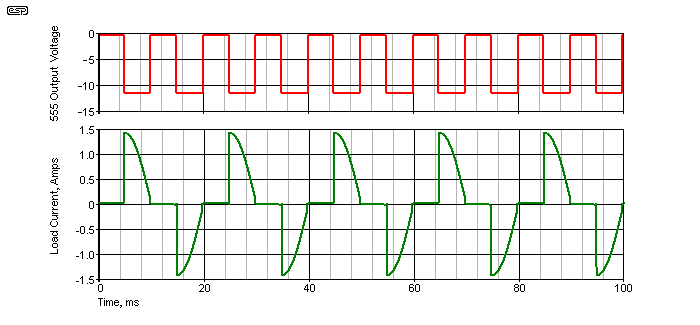
Figure 4 - Load And U1 Output Waveforms
The upper trace (red) shows the output voltage from U1, and the lower trace shows the load current. The load I used in the simulator was a 230 ohm resistor, which will dissipate 230W at 230V AC (with the dimmer set for full power). The power with the waveform shown (the dimmer is set to 50%) is 125W - exactly half.
There are several other waveforms, but they aren't very interesting. The output from the zero crossing detector is positive, with narrow (about 1ms) negative pulses as the AC passes through zero 100 times each second. The voltage across C1 is a ramp, which terminates when the voltage reaches 8V (2/3 supply voltage). At that instant the output of the 555 goes low, turning on the TRIAC and allowing current through the load.
There's something interesting you need to be aware of too. If you measure the load current using a true RMS meter, you'll find that the load current from the mains is about 740mA at the 50% setting. If you calculate power, you get a figure of 170VA (you just calculated VA, not Watts). If the load dissipates a true 125W and you measure an input of 170VA, the power factor is 0.73 - calculated by ...
Power Factor = Real Power (W) / Apparent Power (VA)
Few hobbyists understand power factor, and even some engineers get it wrong. Your electricity meter will register only true power (watts), and that's what you are charged for. Apparent power (VA, or volt amps) is that which has to be supplied via the electricity distribution system. Suppliers don't like a poor power factor because it reduces the capacity of their network. For more on this (if you are interested), see the Power Factor article.
The full circuit using the alternative switchmode power supply is shown below. A small SMPS has the advantage of plenty of output current, high efficiency and circuit simplicity, because you don't have to build it. The disadvantage is that it is physically large, so the dimmer will be somewhat bigger than it would be using the simple capacitor-fed supply shown in Figure 2. Depending on the SMPS used, reliability may be an issue in some cases. My prototype unit used a small (and cheap) Chinese made supply, and although it appears well made its reliability is an unknown factor. (See Project 157 for more details.)
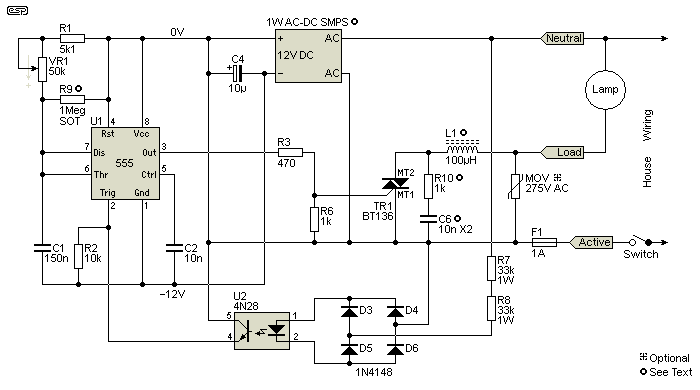
Figure 5 - Using A Small SMPS
The size difference isn't as great as you might imagine though, because the 470nF X2 cap needed for the supply, plus the diodes, zener, etc., take up a surprising amount of space. A 470nF X2 cap is the same height as the miniature switchmode supply I used, and has a footprint that's roughly a quarter that of the SMPS. By the time you add the series resistor, diodes and filter caps the total size is actually quite similar.
This arrangement is equally suited to the trigger circuits shown in Figures 2 and 3. If you use the negative supply shown here with the MOC3021 optocoupler, make sure that you get the polarity of the MOC3021's LED right or it won't work. The optocoupler LED turns on when the output voltage from the 555 is low, so the LED's anode (pin 1) connects to the neutral.
I strongly recommend this version (either with direct drive or using the MOC3021) because it completely removes the current constraints imposed by the capacitor-fed supply. Unlike the other circuits, a standard 555 timer can be used because there is no need to try to minimise the supply current.
It's worthwhile to have a look at a traditional 2-wire TRIAC dimmer so you can see the rather large difference in complexity. The dimmer shown below is more or less typical of a quality TRIAC dimmer, which has a dual time constant to prevent 'pop-on' effects, where nothing happens as the pot is advanced until suddenly, the lights 'pop' on and the brightness can then be reduced to the desired level. Some commercial dimmers are even simpler than this, and may not include the inductor and/or fuse to save costs. The 'Load' and 'Neutral' terminals of the dimmer module are interchangeable - there is no polarity sensitivity because the dimmer is designed for use with AC.
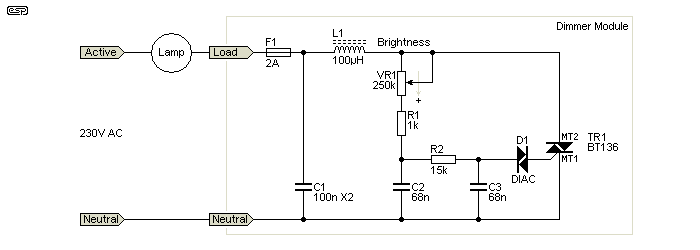
Figure 6 - Traditional 2-Wire Dimmer
The difference is very obvious, and even the 2-wire dimmer shown is a great deal simpler than a 3-wire version. The simplifications are possible because the voltage across the dimmer components (the brightness pot in particular) is limited by the load. When the TRIAC turns on, the voltage across all parts is reduced to close to zero. At high brightness settings, VR1 only has a small part of its track in circuit, and if the TRIAC didn't turn on the pot would be destroyed due to excess current.
All 2-wire dimmers have similar characteristics. Voltage (and current) stresses are generally fairly low because when the TRIAC conducts, the voltage across the pots is reduced to (almost) nothing. The above circuit cannot be used in 3-wire mode because VR1 would fail very quickly at high brightness settings. Despite a great deal of searching, I was unable to locate a schematic for any 3-wire TRIAC dimmers (none that I'd trust anyway). Some have attempted to use LDRs (light dependent resistors), to control the TRIAC, but this cannot be recommended because they are not designed to handle mains voltages (and they are rather slow).
There are countless variations on the circuit shown, and a wide range of component values are used. The values have to be changed for use with 120V/ 60Hz. I make no representations for suitability of the circuit shown in Figure 6 - it is included as an example, and is not part of this project. If you build it, you do so at your own risk entirely.
You can see that the dimmer circuitry relies on the load to provide continuity and zero crossing information. Remember, these dimmers were designed for incandescent lamps, and when designed no-one ever envisaged that CFLs and LED lamps would become the normal load. As discussed, the vast majority of electronic loads cannot provide continuity throughout the entire mains cycle, so the dimmer can never get the zero crossing information at the right time. Many electronic lamp manufacturers have tried to solve this problem, but so far with very limited success.
Because of the high voltages that the circuit operates with, construction is critical for user safety. Most will also prefer that using the dimmer doesn't cause their house to burn down, so cutting corners isn't recommended. While the timer, zero crossing detector and power supply (not including the series resistors) can be built using Veroboard or similar, the high voltage circuits must be assembled using tag strips or some other means of providing mechanical stability and electrical safety. Veroboard is unsuitable because the tracks are too close together, are very thin and aren't rated for the current that the circuit can draw.
You actually can use Veroboard, but you must be able to remove entire tracks (or parts thereof) to get acceptable spacing, and any track that carries the load current must be reinforced with tinned copper wire to ensure it can carry the current without melting. This is the approach I took with the prototype shown in Figure 5.
A PCB would be ideal, but there are no plans to make one available. This might change if there is enough interest. Making this dimmer small enough to fit the space available in typical switch boxes will be challenging. Standard 2-wire dimmers in Australia are very compact, but all leading edge types are extremely simple series circuits that only ever work well with resistive (and for some, inductive) loads.
There are no other references because there are comparatively few sensible descriptions on the Net, apart from the above. Most TRIAC dimmers are 2-wire, and suffer from all the issues of any 2-wire dimmer or speed controller with electronic loads. Even fan motor controllers can have serious issues if the mains zero crossing point is not well defined.
 Main Index
Main Index
 Projects Index
Projects Index